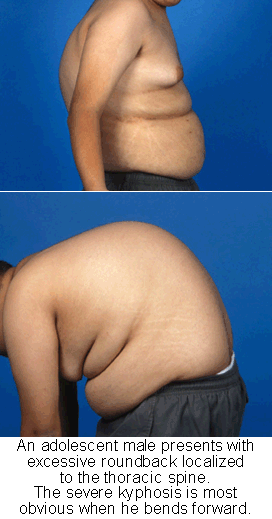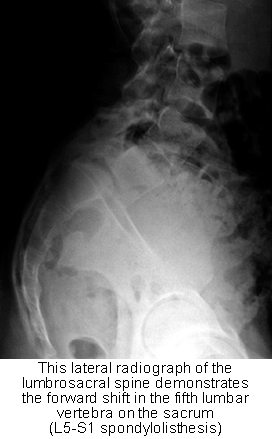Back Pain in Children
These articles are for general information only and are not medical advice. Full Disclaimer. All articles are compliments of the AAOS
Description
Back pain in children is not like back pain in adults. Compared with an adult, a child with a backache is more likely to have a serious underlying disorder. This is especially true if the child is 4 years old or younger, or in a child of any age who has back pain accompanied by.
- Fever or weight loss
- Weakness, numbness, trouble walking, or pain that radiates down one or both legs
- Bowel or bladder dysfunction
- Pain that interferes with sleep
Muscle strain in the middle or lower back gets better on its own with rest. Many teenagers may have “mechanical low back pain.” This is often related to tight hamstrings and weak abdominal muscles. These individuals seem to do well with a physical therapy program stressing hamstring stretching and abdominal strengthening.
More serious causes of back pain need early identification and treatment or they may become worse. Always see a doctor if your child’s back pain lasts for more than several days or progressively worsens.
Doctor's Exam
The doctor begins with a complete history of the problem and physical examination.
History
Tell the doctor everything about your child and his or her back pain.
- Give the complete medical history: How is the child’s overall health? Does he or she have any diseases or medical conditions? Is there any family history of disease? Has the child been in an accident?
- Describe the back pain and any other medical problems: What is the exact location of pain? Does it extend into the legs? Is there any numbness, tingling, or weakness? Trouble with urination or bowel movements?
- Describe when/how the pain began: Was it sudden, or did it develop slowly over time? When does it hurt-all the time or only with movement? Does it hurt at night? What makes the pain better or worse?
- Tell the doctor if the child is involved in sports or other activities: What sports? How often does he or she train? Describe the playing surfaces.
Physical Exam
The doctor carefully examines the child’s musculoskeletal and nervous (neurological) systems. This may include checking:
- Alignment and mobility of the spine. The doctor feels each vertebra and looks for deformities.
- Posture, how the child walks (gait) and whether he or she can bend over to touch the toes, extend, and bend to the right and left.
- Nerves in the back. With the child lying face up, the doctor raises the legs (straight leg raising test). The doctor may also raise the legs with the child lying face down (reverse straight leg raising test).
- Size and tightness of muscles (i.e., hamstrings).
- Balance, flexibility, coordination and muscle strength.
- Muscle spasm and areas of tenderness.
- Reflexes and reactions to pain and light touch.
Imaging
The doctor may use one or several diagnostic imaging tools to see inside the body.
- X-ray. The doctor may take several X-ray pictures of the spine and pelvis from various angles.
- Bone scan. More sensitive than X-rays, bone scans use a substance the doctor injects into a vein to detect infections, tumors and fractures with a special camera.
- CT scan. Specialized X-rays that show a three-dimensional image, computed tomography (CT) scans let the doctor see bone injuries more clearly.
- MRI. Magnetic resonance imaging (MRI) scans use radio waves to let the doctor see the spinal cord, nerve roots, disks or other soft tissues.
- Lab tests: Laboratory tests may include checking white and red blood cells (complete blood-cell count) and looking for system-wide inflammation (measuring erythrocyte sedimentation rate).
Treatment Options
Most often, musculoskeletal strain is responsible for childhood and adolescent back discomfort. The pain frequently responds to rest, anti-inflammatory medications, and an exercise program. Other more serious diagnoses must always be given consideration. Rounded back (Scheuermann’s kyphosis), stress fracture of the spine (spondylolysis), slipped vertebrae (spondylolisthesis), infection and tumors are among these.
Rounded Back
Scheuermann’s kyphosis is a common cause of middle (thoracic) back pain in adolescents. Vertebrae become wedged, causing a rounded or hunched back. The curve may ache, and pain may get worse with activity. Boys get Scheuermann’s kyphosis more often than girls do, usually around ages 14 to 17. Treatment is usually nonsurgical and includes:
- Using a brace as the child grows may improve the curve.
- If the curve is rigid, the child may need a series of casts.
- Exercises to stretch and strengthen muscles may ease the pain but will not change the rounded back.
Similar symptoms in the lower (lumbar) back may indicate another disorder, lumbar Scheuermann’s disease. This may feel like a chronic backache. It most often affects boys ages 15-17 who take part in sports like weightlifting and football and those who do heavy labor.
Stress Fracture of the Spine
Spondylolysis, or stress fracture, may cause lower back pain in adolescents. Stress fractures may occur during adolescent growth spurts or in sports that repeatedly twist and hyperextend the spine (i.e., gymnastics, diving and football). Pain is usually mild and may radiate to the buttocks and legs. It feels worse with activity and better with rest. A child with spondylolysis may have a stiff-legged walk with short stride length. Girls are more likely to get stress fractures. Treatments include:
- Rest from activities that caused the stress fracture
- Nonsteroidal, anti-inflammatory drugs (NSAIDS)
- Strengthening exercises for back and abdominal muscles to help control symptoms
- Bracing for several months and follow-up doctor appointments with X-rays to watch for changes
- Surgery to treat painful spondylolysis that does not get better with conservative management
In a few cases, spondylolysis may lead to slipped vertebrae (spondylolisthesis).

Slipped Vertebrae
Spondylolisthesis is the occurrence of one vertebra shifting forward on the next vertebra below. It usually occurs at the base of the spine (lumbosacral junction). In severe cases, the bone narrows the spinal canal and presses on nerves. Treatment may include:
- Restriction from vigorous physical activity in mild cases
- Surgery to stabilize the spine in serious cases
Infection
In young children, infection in a disk space (diskitis) can lead to back pain. Diskitis typically affects children aged 1–5, although older children and teenagers can also be affected. A child with diskitis may:
- Have pain in the lower back or abdomen and limited range of motion of the spine
- Limp or refuse to walk
- Squat with a straight spine to reach a toy on the floor, rather than bend over
- To treat diskitis, the child may need several days of bed rest and antibiotics taken through the bloodstream (intravenous or IV) or in tablets. In some cases, older children may need casting or bracing to immobilize the spine (for comfort) if infection narrows the disk space. Rarely is surgical drainage of infection needed.

Tumor
On rare occasions, tumors can be responsible for back pain. Spinal tumors usually happen in the middle or lower back. Pain is constant and progressive, unrelated to activity and/or happens at night. Other symptoms vary, depending upon severity. The child may have:
- A “tight” back or muscle spasms. He or she may lean to one side when bending forward (painful curvature)
- Pain and/or weakness extending into the legs. The child may limp
- Bowel and/or bladder dysfunction
